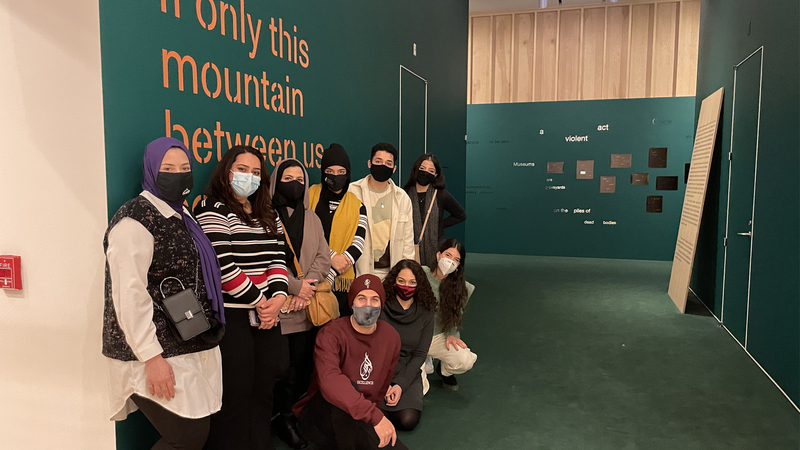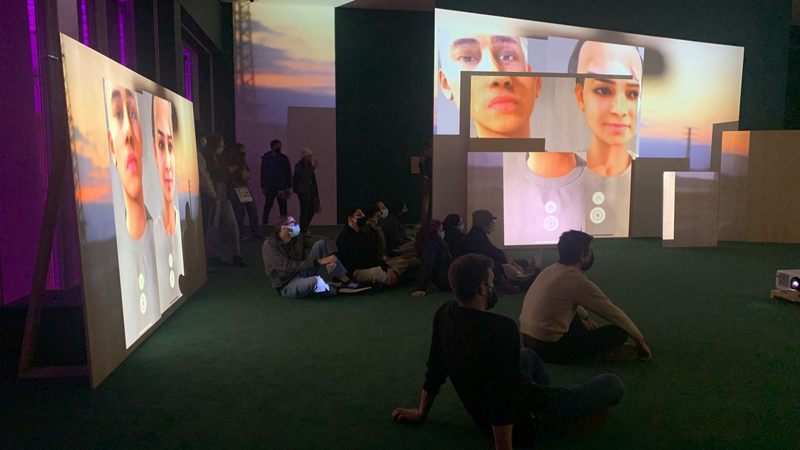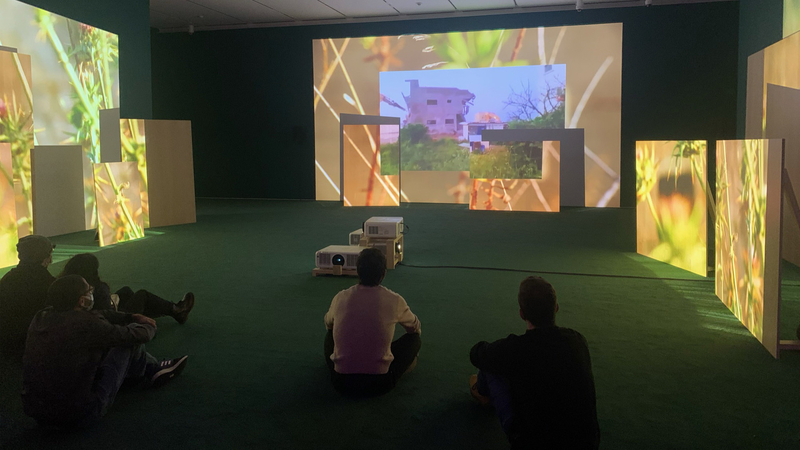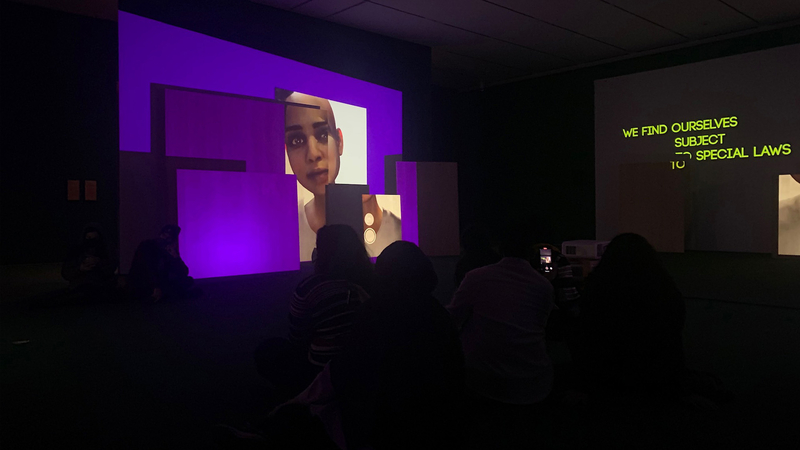The Sunday after the AMP Convention in Chicago, AMP members and guests visited the Art Institute of Chicago and went on a guided tour of the exhibition by Basel Abbas and Ruanne Abou-Rhame: “If only this mountain between us could be ground to dust” curated by Maite Borjabad.
This is the first exhibition by Palestinian artists Basel Abbas and Ruanne Abou-Rahme in a major US museum – and it combines a site-specific installation of the artists’ ongoing multimedia projects with a newly commissioned work created specifically for the Art Institute of Chicago.
We paused at the entrance of the exhibit with curator Maite, who explained to us the symbolism in the presentation and the content we were going to experience. She told us about the fascinating artistic practice of Basel and Ruanne, their backgrounds, their work, and their processes.

At the entrance of the exhibition, it was a series of prints titled “Don’t read poetics in these lines.” As the curator writes, “Abbas and Abou-Rahme began producing this work in 2010 by screenshotting and archiving tweets that responded and continue to respond to the Arab revolutions. The selectively erased texts distill the rapid-fire reactions that unfolded on social media, thus standing as a testament to our time and offering a physical counterweight to the internet, which the artists consider an ‘amnesiac archive.’” The work claims that there are numerous dimensions of history and its narratives – there is no singular narrative even on seemingly factual and sterile historic events.
As the exhibition text reads, “the four interconnected works on view present broken narratives and fragmented compositions that critically foreground the sociopolitical reality of violence and oppression in Palestine – all too often under reported in media and unrecorded in historical accounts. At the same time, it brings attention to how images that circulate online can offer a testament to historic events, though that testament can be obliterated when the internet becomes oversaturated with imagery.”

On the other side of the wall, the exhibit presents two sound and video works that create an immersive experience, that brings a deep and visceral touch through deep vibration frequencies that are difficult to explain but so intuitively experienced and understood. One must truly live it for themselves to understand how the artist’s works are able to represent with careful sensitivity the terrifying reality that Palestinians experience but at the same time bring the poetics and claim for liberation through some words sampled from Edward Said’s After the Last Sky.
One of the sound and video pieces “At those terrifying frontiers where the existence and disappearance of people fade into each other” features avatars rendered from images of Palestinian demonstrators at the Great March of Return. Looking distorted and scarred because of the process of converting low-quality images into a high-quality avatar character, the digital glitches seemed like a metaphor for the scars of horror and atrocities Palestinians have witnessed during their lifetime, and the forced anonymity they have to carry – not being able to share their activism, face, or work publicly for fear of persecution by Israel. Their faces felt like fictional but also very human figures that seemed like singing in a way Said’s words for liberation, creating a very empowering effect.

Installation shot of If only this mountain between us could be ground to dust, 2021. Image courtesy of the Art Institute of Chicago
Curator Maite expounded on the richness of Basel and Ruanne’s artworks, both on the artistic dimension but also on the political significance of having the first Palestinian exhibition at the Art Institute of Chicago. As she writes: “The exhibition reframes and activates narratives that the artists describe as everyday erasure of Palestinian experience as a means of resisting the illusion of one immutable history, challenging the ways that history is constructed and continually obliterated.”

You can find the full exhibition overview here. It is hard to put in words what we experienced while being there and how powerfully Palestinian voices were being amplified and empowered. We highly recommend taking your friends, family, and even yourself to visit the exhibit in support of this riveting project on view through January 3, 2022, at the Art Institute of Chicago.
Free Palestine!
This article was first published on the American Muslims for Palestine blog on December 23, 2021.
Malak Shalabi
Malak Shalabi works as the Media Coordinator with American Muslims for Palestine. She has written on torture, occupation, and U.S. imperialism in the Middle East. She is an immigration attorney based out of Seattle, Washington.
BEFORE YOU GO – Stories like the one you just read are the result of years of efforts by campaigners and media like us who support them by getting the word out, slowly but doggedly.
That’s no accident. Our work has helped create breakthroughs in how the general public understands the Palestinian freedom struggle.
Mondoweiss plays a key role in helping to shift the narrative around Palestine. Will you give so we can keep telling the stories in 2022 that will be changing the world in 2023, 2025 and 2030?
 RSS Feed
RSS Feed















 December 25th, 2021
December 25th, 2021  Awake Goy
Awake Goy  Posted in
Posted in  Tags:
Tags: 













